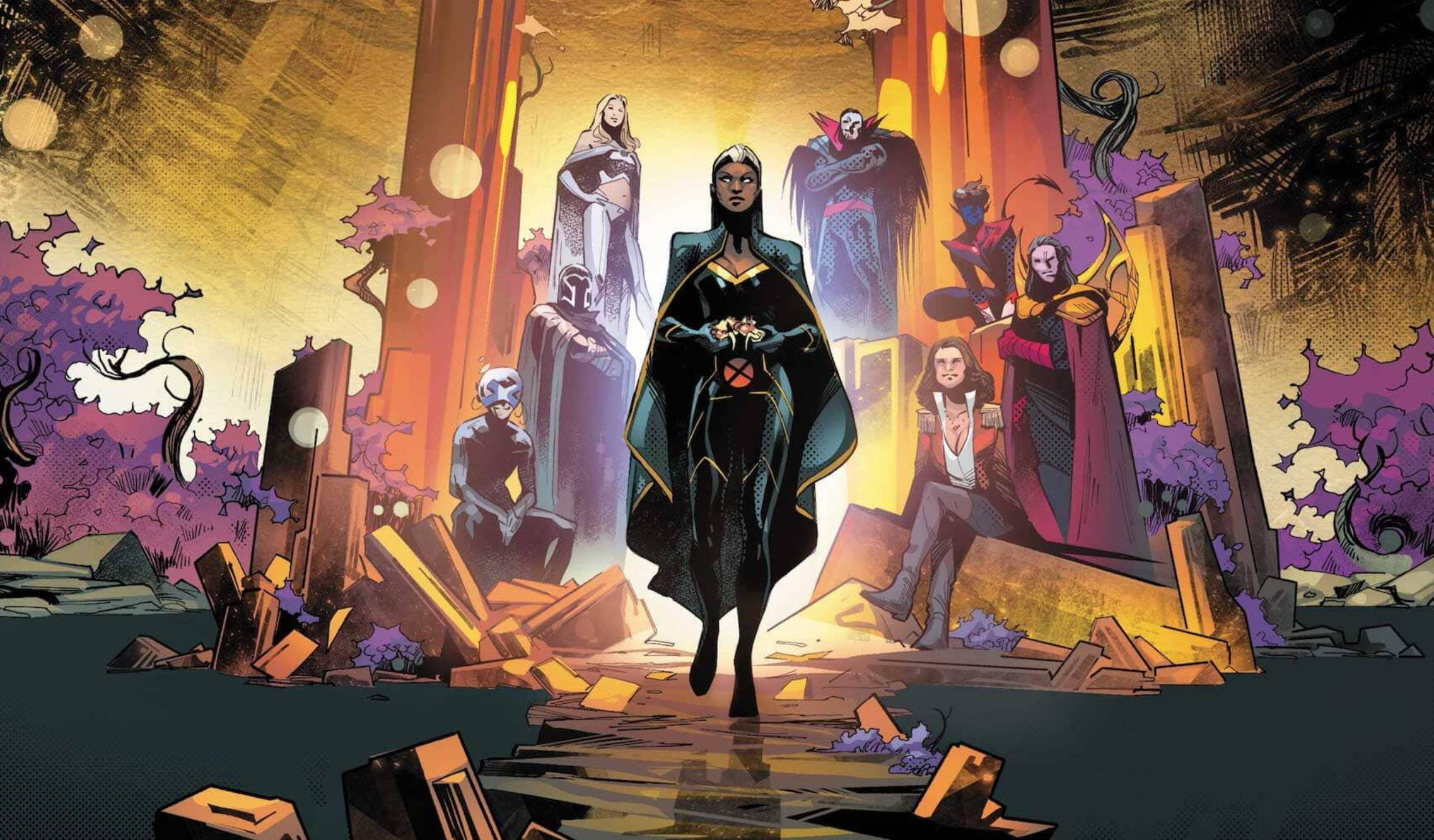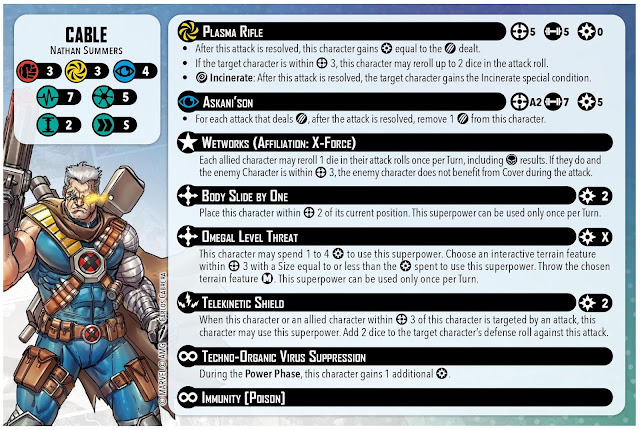
Welcome back to class! Take a seat!
In this article, I’ll be going over the latest changes to some of the Uncanny X-Men characters and how I think they fit in the affiliation going forward.
First, I’ll be going over what I think are the biggest changes; the Leaderships.
X-Men Gold was, by far, the most popular of the X-Men leaderships available and it got hit with two pretty significant changes. It reads:

The first change is that, now, the X-Men jumps costs a power instead of being free. This changes mostly how it plays on rounds 1 and 2, where if you want a character to both use the Jump and interact, they either need to start their activation with 2 power or, if First Class was played, be an affiliated X-Men character. In round 2, it can slow down the character using it by taxing its power economy early on, which I think makes its usage sometimes a little more awkward but not enough for it to be significantly worse than it was.
The second part of the leadership and, in my opinion, the biggest change it received is now that instead of granting cover against attacks coming outside R2, it gives the target of the attack a defensive reroll. Cover, on average, represents roughly the equivalent of 2 additional defense dice when it comes to blocks. As opposed to a reroll, which has a roughly 38% chance to convert an unsuccessful block to a successful one. However, this is not strictly worse, as it now allows to gain Cover from terrain and scenario tokens which, in those cases, makes the defensive part of the leadership better.
Now unto X-Men Blue.

X-Men Blue was almost completely overhauled and changed the way to build around the leadership drastically. Instead of functionally sharing power between models within R3 to use on spenders, it’s now generating power for allied models within R5, which is an upgrade in both net power (it generates instead of redistributing) and range (R3 to R5). Having a leadership that helps generate power changes the priorities in list building, as now it can enable some of the more power-hungry members of the affiliation.
Now let’s go over the individual character changes.
Storm

Besides X-Men Gold, Storm received two changes that may not look like much but change the way she plays on the table a lot. First is that Eye of the Storm went from 3 to 2, which, especially if combined with First Class, lets her start firing 6 dice energy bolts as early as round 2, which in turn lets you use it more often and makes her more proficient at using the rest of her kit (especially her throw). Under the revamped X-Men Blue, her beam also becomes an interesting option to try and generate power for your other models. Hurricane also got an extra attack dice (moving from 5 to 6) which makes it more threatening than it was, especially when combined with Eye of the Storm. Overall, Storm feels a lot more proactive than she was before on the table, being able to make stronger attacks more regularly and throw other models or terrain more often, she doesn’t feel like the backpoint sitter she often was.
Cyclops

Cyclops’s builder was the part of his card that received the most improvement. Now he gets to push characters size 3 or less (up from 2) and gets an additional trigger that can give him an extra attack on another target with R4 of him (which could let Cyclops trigger his leadership up to 4 times in his activation!). The wild trigger on his spender was also changed from losing 1 power if you rolled a wild, to the targets losing 1 power per wild in the attack roll. Overall I think Cyclops gained a lot of consistency to leverage his kit a lot more effectively. In my book, Field Leader was always the stand-out superpower in his kit and getting to use it more often only makes Scott stronger than he was.
Cable

Cable received some noticeable improvements. Getting +1 health on his healthy side makes him a little more survivable and not as likely to get dazed early in the game. His builder getting 2 rerolls when he attacks from R3 improves his consistency of damage significantly when he gets in the thick of it, which in turn helps him generate power, to spend either on his throw or to shield himself and his allies. The extra health also makes his spender (now 1 power cheaper) more accessible even if it loses its Stagger trigger on his injured side. Overall, Cable feels a lot better to play, being able to either attack from afar or get into the action to provide solid offensive pressure.
Colossus

Colossus received a few, but very important changes on his card. His movement was upgraded from short to medium which lets him use and leverage his kit more reliably. His spender’s range went from 2 to 3, making him able to use it without having to compromise his positioning as much as before. The Big Brother superpower also was changed, going from a Bodyguard type effect (needing to be within R2 of the target of the attack) to a Taunt type effect (needing to be within R2 of the attacker). This puts a bigger emphasis on how well positioned is Colossus if you want him to be diverting attacks away. Finally, Organic Steel now makes Colossus immune to pushes from enemy effects and, combined with his newfound mobility, makes him relatively hard to control on top of his innate resiliency. Overall, Colossus feels like an impressive presence on the board and a more proactive player in the affiliation.
Jean Grey

Like her fellow affiliated 5 threat, Jean also got pretty relevant changes to her kit and arsenal. Starting with her builder, it received a pierce trigger on a failure, which will nudge her average damage up and let her use the rest of her superpowers more consistently. Her spender, which was already pretty impressive, if expensive, received a discount and now costs 5 power (down from 6) which lets Jean use it a lot more often than before.
In my opinion, the most significant change she received, was to her passive superpower, Latent Psychic Potential, which now lets her generate 3 power per turn. This I think has the biggest impact on her play patterns very early in the game, as, on round one, she can now either move twice and displace an activated model (friend or foe) with Matter Transmutation, double move and throw a size 4 terrain (preferably on a model that interacted and can’t spend power to use Brace for Impact). She can use Shield Mind and still have the power to interact with an objective without having to use First Class. Finally, if you’re playing her TTC Mental Domination, she can move twice and play the card, displacing an opposing model and giving you a free attack into them.
Wolverine

Last but not least, Wolverine was the recipient of some important changes to his character card. His superpower, The Best At What I Do, saw a cost reduction and went from 3 power to 2 power and also lets him use his charge on the spender. This increases his mobility and helps him get the ball rolling on his attacks and improves his power economy. The other important change Wolverine received was +1 health on his injured side putting him at 6 health. This is important as it reduces the chances of Wolverine getting taken off the table easily once he’s injured and makes Wild Rage a lot of dangerous than it previously was. By virtue of being a better character, the tactics cards available to Wolverine also get an improvement. Fastball Special now makes for a very interesting card between the improved versions of Colossus and Wolverine and Weapon X Program can help Wolverine deal an impressive amount of damage.
All in all, I was very impressed by the changes to the old guard of MCP’s X-Men. A brand new leadership to use and additional diversity of character choice and strength based on the kind of team you want to play has been very welcome.
Thanks a lot for taking the time to read this piece and as always, don’t forget to have fun!

